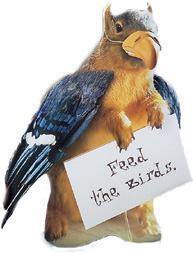-
A New Generation of Window Bird Feeders
Bringing birds up close truly enhances any backyard birding experience. Window bird feeders allow for some perfect moments, with incomparable views to those of feeders placed further away in the yard.
New-fangled hangers, and advanced mounting hardware ensure stability for substantial, and larger capacity window bird feeders. Selections are widely available in glass, wood, durable recycled plastics, acrylics, and resin. Styles range from open and covered trays, hoppers, tube feeders, and dish-like feeders for meal worms or fruit. Even the type of birds you wish to attract can be determined by your choice of window feeder. Nectar, thistle, seed mix, peanut or suet feeders? Some window hummingbird feeders will easily convert to seed feeders for winter use.
This stylish mahogany window feeder actually holds three quarts of black oil sunflower, or other mixed seed. With its innovative design, seed stays dry and fresher longer, and birds are also protected from the elements while feeding.
One suggestion for window bird feeders is to use a no-mess seed mix, or sunflower hearts and chips. Usually placed on deck or porch window, there will be little to no mess below…on your deck, porch, or grass. Window bird feeders make perfect and long lasting gifts for any nature lover on your list too…and for virtually any occasion. Truly a gift recommended by Mother Nature herself!
-
Foiled by the Squirrel Baffle
He’s arch enemy number one to most backyard birders! Raiding bird feeders relentlessly until empty, they continue even to destroy the feeder itself. Squirrels can be an impossible pain in the keester, no matter how you try to solve the problem.
To the rescue…a quality squirrel baffle placed in the correct position. When installed properly, squirrel baffles make it impossible for these furry critters to get
at feeders. Because of their amazing acrobatics, you must always remember it’s not just the height from the ground, but the horizontal distance from any jumping spot. They can leap tall buildings at a single bound, so feeders must be at least eight feet away from where squirrels can get a foot hold and jump across.
With the investment of a squirrel baffle (and they really aren’t even that expensive) you’ll save money by saving birdseed. You’ll also allow your feathered friends to dine in peace, thus seeing more of the activity you were hoping for.
If the squirrel baffle is a pole mounted one, be sure the bottom of the baffle is at least five feet from the ground. Squirrels will shimmy on up the pole, but will be foiled every time by the baffle. Knowing that you’ve finally won the battle, it’s a pretty entertaining site too!
-
Want more birds at your nyjer feeder?
There are no set rules in wild bird feeding, we offer birds different varieties of food that entice them and keep them coming back. Of course habitat plays a huge role, with places for shelter and nesting like mature trees, thickets and shrubs. The all important water source is also a big factor for attracting feathered friends.
Just because finches eat thistle, or nyjer seed, doesn’t mean they wont’ frequent other feeders offering different seed mixes. For the last few days, I’ve been seeing Black Capped Chickadees at the nyjer feeder. Now maybe it’s just the time of year, but I’ve never seen them at this feeder before. Also, the juvenile Eastern Bluebirds, who will eat suet during our cold winter months, have already started feeding at the suet feeder too.
A favorite treat for several birds is to mix thistle seed with finely chopped sunflower hearts. Placing this seed mix in the nyjer feeder attracts Juncos, Pine Siskins, Towhees and House and Purple Finches, as well as the Goldfinch.
In early spring, try offering nesting materials and encourage birds to take up residence by nesting in your yard. Collect dryer lint, pet hair, cotton yarns and fibers, and decorative mosses to create a nest ball with variety of materials that birds prefer. You can place them in a standard suet cage, or mesh produce bag from the grocery store. Of course commercial materials are available, and even some cool holders to accommodate them.
Just because the bright yellow feathers disappear in fall, it doesn’t mean these birds are gone. Remember to keep nyjer feeders out year round with fresh seed, as goldfinches and others will stick around during during winter months.






